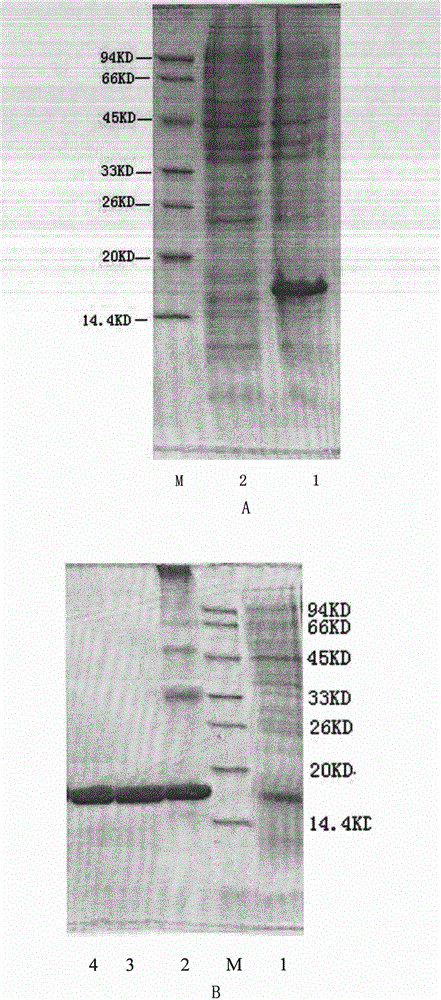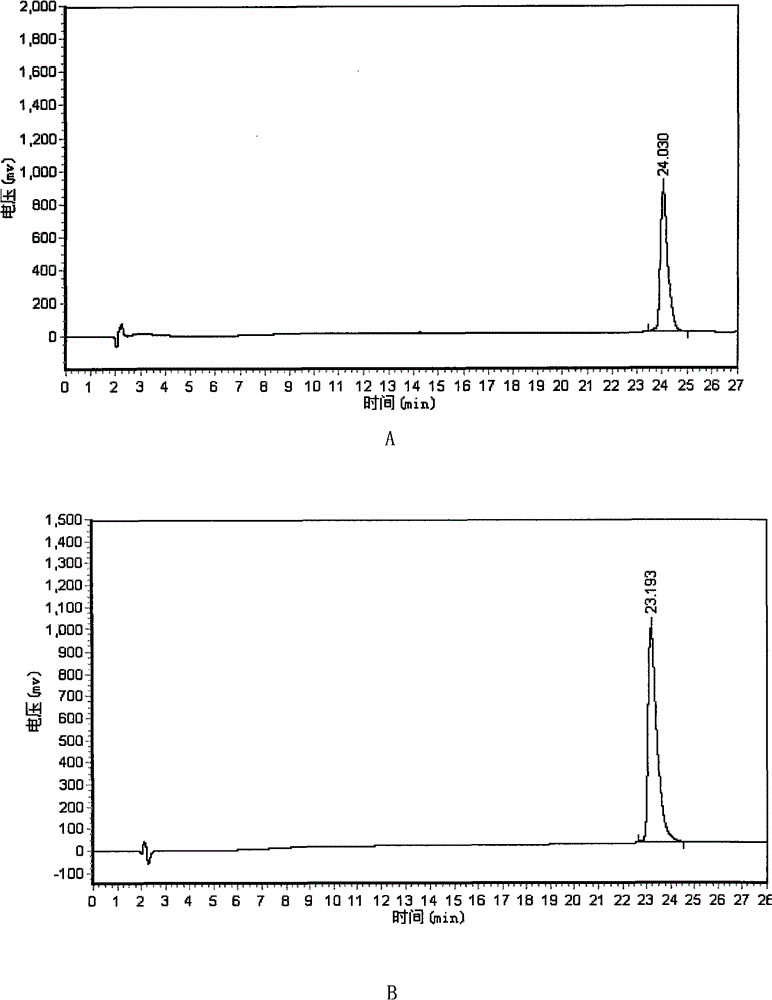Chemical conjugate of recombinant deleted human keratinocyte growth factor type I
A technology of keratinocytes and growth factors, applied in the direction of fibroblast growth factors, growth factors/inducing factors, animal/human proteins, etc., can solve the problems of low specificity and product heterogeneity, and protect acute liver injury , the effect of protecting acute small intestinal mucosal injury
- Summary
- Abstract
- Description
- Claims
- Application Information
AI Technical Summary
Problems solved by technology
Method used
Image
Examples
example 1
[0036] Example 1. Recombinant Expression of Human Keratinocyte Growth Factor Type I (Δ23hKGF) Deleting N-terminal 23 Amino Acids
[0037] According to the amino acid sequence of Δ23hKGF (SEQ ID No: 1), the corresponding cDNA sequence of Escherichia coli biased codon was designed and included the 5' end and 3' respectively design restriction endonuclease Nde I and BamH I site (SEQ ID No: 2 ). Entrust Bao Bioengineering (Dalian) Co., Ltd. to artificially synthesize the whole gene, insert it into the pUC18 vector and name it pUC18-Δ23hKGF / DH5α.
[0038] Plasmid pUC18-Δ23hKGF DH5α and expression vector plasmid pET-3c were double-digested with restriction endonucleases Nde I and BamH I, and subjected to 1% agarose electrophoresis to recover the fragment of about 4638bp after digestion of pET-3c and pUC18- After Δ23hKGF / DH5α digestion, the fragment of about 450bp was digested, and the two fragments were connected with T4 ligase into plasmid pET-3c-Δ23hKGF, and then the plasmid pET-...
example 2
[0040] Example 2, the purification and preparation of Δ23hKGF and r-Δ23hKGF
[0041] Take out the bacteria from the refrigerator at -20°C, put them into the bacterial lysate (50mmol / L Tris-HCl, 5mmol / LEDTA, 10μg / ml DNase, 2mmol / L MgCl) at 1:15w / v 2 , pH 8.5-9.0), stirred at 37°C and added trisodium citrate with a final concentration of 0.1M when the bacteriostasis solution was not viscous, and continued to stir for 0.5h. Adjust the pH to 7.5, centrifuge at 10,000 rpm for 15 min, and collect the supernatant. Put the supernatant on the SP-Sepharose Fast Flow column (equilibrium solution: 50mmpb, pH7.5), rebalance, and elute with a linear gradient of 50-500mmNacl, collect the elution peak, and detect by SDS-PAGE to determine the content of the main target protein. Elution peak. The target sample eluted by SP is put on the Heparin column (equilibrium liquid: 20mm pb, pH7.5), rebalanced, and eluted with a linear gradient of 50-500mm Nacl, and the elution peak is collected, detect...
example 3
[0042] Example 3, mPEG-MAL-20K modification of r-Δ23hKGF and purification after modification (PEG-20K-Δ23KGF)
[0043] The r-Δ23hKGF solution with a purity greater than 95% was diluted with 100mmol / L phosphate buffer, pH 6.5, to 2 mg / mL, and mixed with r-Δ23hKGF and mPEG-MAL-20KD (linear type, purchased from Beijing Jiankai Technology Co., Ltd. Co., Ltd.) with a mass ratio of 1:3, weighed mPEG-MAL-20KD and added it to r-Δ23hKGF solution, stirred and reacted at 100 r / min at 25°C for 2 hours, and lowered the pH with hydrochloric acid to terminate the reaction. The modified r-Δ23hKGF (PEG-20K-Δ23KGF) solution was dialyzed overnight (dialysate: 20mmNaAc, pH 5.0), and the dialyzed PEG-20K-Δ23KGF solution was applied to SP-Sepharose Fast Flow column (equilibrium: 20mmNaAc, pH5.0) .0), rebalanced, eluted with a linear gradient of 50-500mm Nacl, collected the eluted peak, and detected by SDS-PAGE and HPLC, obtained PEG-20K-Δ23KGF with a purity greater than 95% ( figure 2 , image 3 )...
PUM
| Property | Measurement | Unit |
|---|---|---|
| molecular weight | aaaaa | aaaaa |
Abstract
Description
Claims
Application Information
 Login to View More
Login to View More - R&D
- Intellectual Property
- Life Sciences
- Materials
- Tech Scout
- Unparalleled Data Quality
- Higher Quality Content
- 60% Fewer Hallucinations
Browse by: Latest US Patents, China's latest patents, Technical Efficacy Thesaurus, Application Domain, Technology Topic, Popular Technical Reports.
© 2025 PatSnap. All rights reserved.Legal|Privacy policy|Modern Slavery Act Transparency Statement|Sitemap|About US| Contact US: help@patsnap.com



